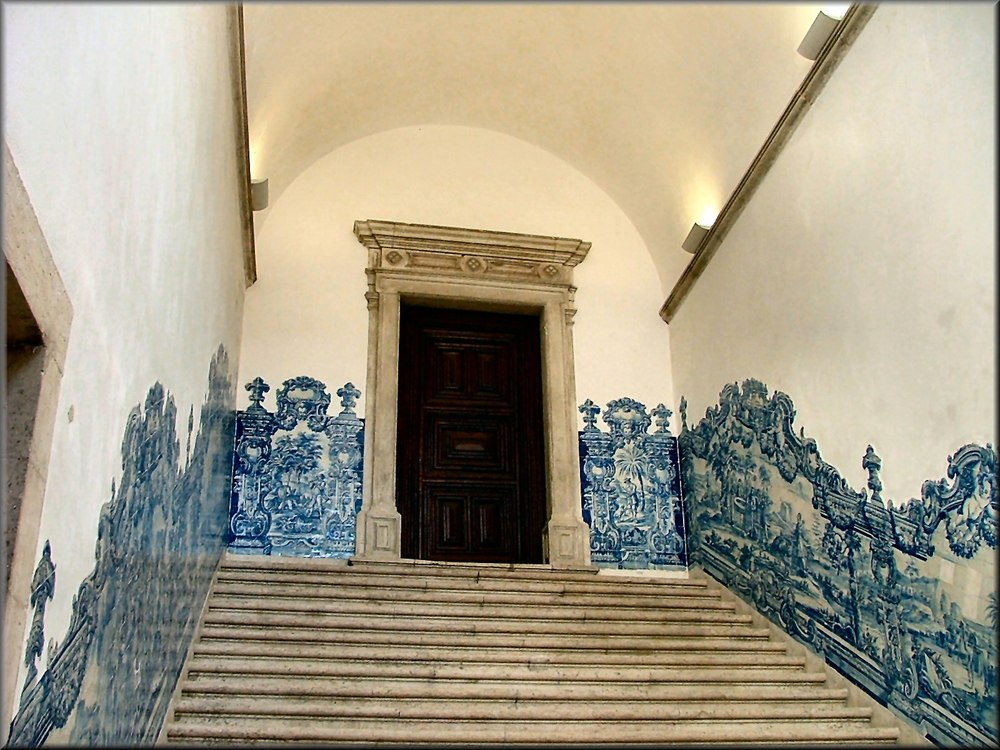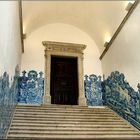* STAIRS *
The Church or Monastery of São Vicente de Fora meaning "Monastery of St. Vincent Outside the Walls" is a 17th century church and monastery in the city of Lisbon. It is one of the most important monasteries and mannerist buildings in the country. The monastery also contains the royal pantheon of the Braganza monarchs of Portugal.
The original Monastery of São Vicente de Fora was founded around 1147 by the first Portuguese King, Afonso Henriques for the Augustinian Order. The Monastery built in Romanesque style outside the city walls, was one of the most important monastic foundations in mediaeval Portugal. It is dedicated to Saint Vincent of Saragossa, patron saint of Lisbon, whose relics were brought from Algarve to Lisbon in the 12th century.
The present buildings are the result of a reconstruction ordered by King Philip II of Spain, who had become King of Portugal (as Philip I) after a succession crisis in 1580. The church of the monastery was built between 1582 and 1629, while others monastery buildings were finished only in the 18th century. The author of the design of the church is thought to be the Italian Jesuit Filippo Terzi and/or the Spaniard Juan de Herrera. The plans were followed and modified by Leonardo Turriano, Baltazar Álvares, Pedro Nunes Tinoco and João Nunes Tinoco
Die Kirche oder Kloster von São Vicente de Fora im Sinne
von "Kloster von St. Vincent vor den Mauern" ist ein aus
dem 17. Jahrhundert Kirche und das Kloster in der Stadt
Lissabon. Es ist eines der wichtigsten Klöster und
manieristischen Gebäude des Landes. Das Kloster enthält
auch das königliche Pantheon der Könige von Portugal
Braganza.
Das ursprüngliche Kloster von São Vicente de Fora wurde um
1147 durch die erste portugiesische König, Afonso Henriques
für den Augustiner-Orden gegründet. Das Kloster im
romanischen Stil außerhalb der Stadtmauern errichtet, war
einer der bedeutendsten Klöster im Mittelalter Portugal. Es
ist dem Heiligen Vinzenz von Saragossa, dem Schutzpatron
von Lissabon, dessen Reliquien wurden aus Algarve nach
Lissabon im 12. Jahrhundert brachte gewidmet.
Die jetzigen Gebäude sind das Ergebnis einer Rekonstruktion
von König Philipp II. von Spanien, der inzwischen König von
Portugal (als Philip I) nach einer Reihe Krise im Jahr 1580
bestellt hatte. Die Kirche des Klosters wurde zwischen 1582
und 1629 erbaut, während andere nur Klostergebäude aus dem
18. Jahrhundert fertig waren. Der Autor der Gestaltung der
Kirche wird angenommen, dass der italienische Jesuit
Filippo Terzi und / oder der Spanier Juan de Herrera sein.
Die Pläne wurden verfolgt und von Leonardo Turriano,
Baltazar Alvares, Pedro Nunes Tinoco und João Nunes Tinoco
geändert
( Vielen Danke Erwin Frei )
22 February 2012

«Monastery of São Vicente de Fora»
Vitória Castelo Santos
































anne_wolf_60 08/04/2024 22:08
Klasse!Swiss Photo 09/02/2024 18:26
Klasse Beitrag! Gruss s.p.SINA 05/02/2024 17:18
Eine ganz tolle AufnahmeExzellent
Bravo
Ich wünsche dir viele schöne Vorfrühling Tage
Herzliche Grüße von Sina
Alfred Photo 28/01/2024 22:42
Tolle Kunst und AusstrahlungVG
Alfred
mme. sans-importance 24/01/2024 21:41
Schön gezeigt - danke für die informative Doku.LG, Miri
Manfred Ihrig 24/01/2024 17:19
Sehr schön sieht es das aus !LG Manfred
Ga Schü 24/01/2024 16:04
Seht interessant gestaltet.LG Gaby
Jean COLLETTE 23/01/2024 16:26
C'est superbe !Amts
thomson w 23/01/2024 8:22
Das ist mal ein Treppenaufgang , oben sehr einfach ,dafür unten sehr schön gestaltet . AG ThomasMario Siotto 22/01/2024 18:36
Jolie vue de cette montée de cette fresqueAmitiés
Mario
Hans J. Mast 22/01/2024 17:06
Schöner Blickwinkel.LG Hans
Eva Loth 22/01/2024 15:55
ein toller Blick hinauf .... LG EvaRainer Switala 22/01/2024 12:50
sehr schönes nostalgisches motivgruß rainer
Frank G. P. Selbmann 22/01/2024 12:17
ein sehenswertes kloster, liebe vitoria!einen angenehmen wochenstart wünscht dir franKS
felipe Martínez Pérez 22/01/2024 0:21
Estupenda imagen